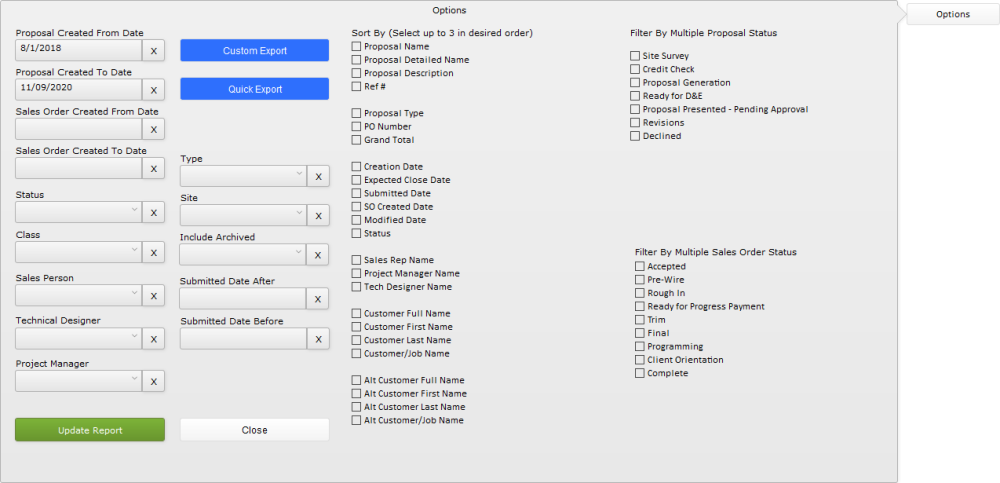The Proposal Snap Shot report provides a quick financial overview of the proposals generated in the system in a quick, simple to read view. This report also includes proposals that have been converted to sales orders.
Here you’ll find:
- Customer – the name of the ( Bill To ) customer
- Ref# – the system generated proposal number
- Design Name – the Proposal/Sales Order Name
- Type – the user-defined type of proposal
- Status – the current status of the sales order or proposal
- Expected Close – the date when the proposal is scheduled to be accepted/closed
- Proposal Submitted – the date that the proposal was marked submitted or delivered to the customer
- SO Created – the date & time stamp of when the proposal was converted into a sales order
- Total – the sale price to the customer
- Profit – the amount of profit in dollars
- Parts – the sale price of all the items on the proposal
- Labor – the sale price of all labor for the job
- Misc – the amount of the Misc Parts modifier
- Discount – the total of the Discount 1 modifier
Note: Clicking on any line in the report will open the associated proposal or sales order.
There are a lot of options here, so let’s review them one by one.
Filters
- Proposal Created From/To Date – specifying dates here will display proposals that were created in the date range specified (this will include proposals created within the date range that are now sales orders)
- Sales Order Created From/To Date – this date range will show sales orders that were converted from a proposal to a sales order within the specified date range
- Status – filter jobs on the report based on the Sales Order status
- Class – use the drown down list to find jobs assigned to a specific class
- Sales Person – show jobs assigned to a particular salesperson
- Technical Designer – filter the list based on jobs where a particular individual is the technical designer
- Project Manager – use the project manager as a filter on the list of displayed jobs.
- Type – find jobs that are defined with a specific type
- Site – if your company is using Multi-Site Inventory, find jobs that are associated with a particular location
- Include Archived
- Show Only – show only jobs that have been archived
- Don’t Show – don’t show any jobs that have been archived
- Show All – show all proposals and sales orders regardless of their archived status
On the far right side of the Options screen are two checklist-style filters.
- Proposal Status – place a check in multiple checkboxes to include one or more proposal statuses on the report.
- Sales Order Status – the Status dropdown on the left side of the screen only allows one sales order status to be used. But if you wanted to grab multiple SO statuses on the report, use the checkboxes to filter the list with multiple statuses.
Sort By
The center section shows a list of checkboxes where you can define how the filtered list is sorted. This is a hierarchical sort defined by the boxes checked. You can use up to three sorts in a single report. Check the sort order in the order you want jobs to be displayed.
For example, if you wanted to show all jobs sorted by salesperson first and then sorted by customer, first check Sales Rep Name and then check Customer Last Name. Choosing those two boxes would cause Aaron’s customers to be sorted alphabetically under Aaron followed by Zach’s list of alphabetical customers’ jobs. Each sort header will display totals for that section of data.
We won’t define each sort option here in the manual, as their names are fairly self-explanatory.
Buttons

This report has a lot of information on it and doesn’t necessarily fit onto a printed page. So rather than printing the report, you’ll export it to Excel or some other spreadsheet program.
- Click the Custom Export button
- Choose the location where you want to store the exported file on your computer
- Be sure to also define the file type. Typical choices are .csv, .tab, or .xlsx
- You will be presented with a Specify Field Order for Export window
- Choose the data fields from the left side of the window and move them to the export Field Export Order
- Remove unwanted fields from the Field Export Order
- Click the Export button
- The filtered list will be saved to the location you defined in step 2 and is available for you to open using your third party application.

The Quick Export button functions like the Custom Export option defined above except you don’t get the opportunity to define which fields of data are exported.

Once you have set Filter and Sort options, click the Update Report button






